5 Intro to Graphing
Topics Covered
Plot Points on a Rectangular Coordinate System
Just like maps use a grid system to identify locations, a grid system is used in algebra to show a relationship between two variables in a rectangular coordinate system. The rectangular coordinate system is also called the xy-plane or the “coordinate plane.”
The rectangular coordinate system is formed by two intersecting number lines, one horizontal and one vertical. The horizontal number line is called the x-axis. The vertical number line is called the y-axis. These axes divide a plane into four regions, called quadrants. The quadrants are identified by Roman numerals, beginning on the upper right and proceeding counterclockwise. As shown in the figure below.
The signs of the x-coordinate and y-coordinate affect the location of the points. We can summarize the sign patterns of the quadrants in this way:
| Quadrant I | Quadrant II | Quadrant III | Quadrant IV |
|---|---|---|---|
| (x ,y) | (x, y) | (x ,y) | (x, y) |
| (+, +) | (−, +) | (−, −) | (+, −) |
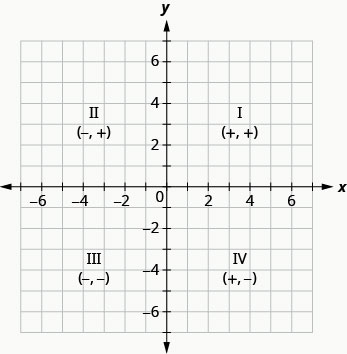
In the rectangular coordinate system, every point is represented by an ordered pair. The first number in the ordered pair is the x-coordinate of the point, and the second number is the y-coordinate of the point. The phrase “ordered pair” means that the order is important.
An ordered pair, (x , y) gives the coordinates of a point in a rectangular coordinate system. The first number is the x-coordinate. The second number is the y-coordinate.

What is the ordered pair of the point where the axes cross? At that point both coordinates are zero, so its ordered pair is (0, 0). The point (0, 0)has a special name. It is called the origin.
The point (0, 0) is called the origin. It is the point where the x-axis and y-axis intersect.
We use the coordinates to locate a point on the xy-plane. Let’s plot the point (1 , 3) as an example. First, locate 1 on the x-axis and lightly sketch a vertical line through x=1. Then, locate 3 on the y-axis and sketch a horizontal line through y=3. Now, find the point where these two lines meet—that is the point with coordinates (1,3).
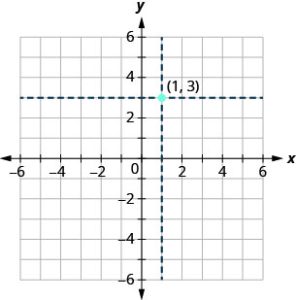 Notice that the vertical line through x = 1 and the horizontal line through y = 3 are not part of the graph. We just used them to help us locate the point (1, 3).
Notice that the vertical line through x = 1 and the horizontal line through y = 3 are not part of the graph. We just used them to help us locate the point (1, 3).
When one of the coordinates is zero, the point lies on one of the axes. As shown in the figure below, the point (0, 4) is on the y-axis and the point (−2, 0) is on the x-axis.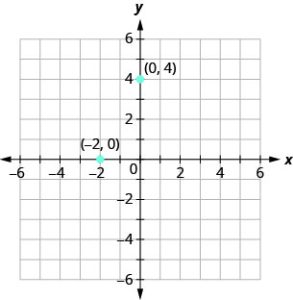
Points on the Axes
Points with a y-coordinate equal to 0 are on the x-axis, and have coordinates (a, 0).
Points with an x-coordinate equal to 0 are on the y-axis, and have coordinates (0, b).
Try it!
- Plot each point in the rectangular coordinate system and identify the quadrant in which the point is located:
a. (−5, 4) b. (−3, −4) c. (2, −3) d. (0,− 1) e. ![]() .
.
Solution
The first number of the coordinate pair is the x-coordinate, and the second number is the y-coordinate. To plot each point, sketch a vertical line through the x-coordinate and a horizontal line through the y-coordinate. Their intersection is the point.
a. Since x = −5, the point is to the left of the y-axis. Also, since y = 4, the point is above the x-axis. The point (−5, 4) is in Quadrant II.
b. Since x = −3, the point is to the left of the y-axis. Also, since y = −4, the point is below the x-axis. The point (−3, −4) is in Quadrant III.
c. Since x = 2, the point is to the right of the y-axis. Since y = −3, the point is below the x-axis. The point (2, −3) is in Quadrant IV.
d. Since x = 0, the point whose coordinates are (0, −1) is on the y-axis.
e. Since x = 3, the point is to the right of the y-axis. Since ![]() , the point is above the x-axis. (It may be helpful to write
, the point is above the x-axis. (It may be helpful to write ![]() as a mixed number or decimal.) The point
as a mixed number or decimal.) The point ![]() )is in Quadrant I
)is in Quadrant I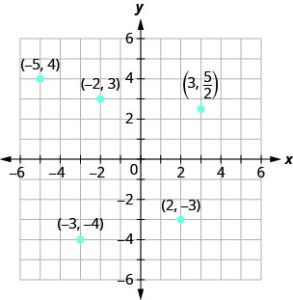
Try it!
Plot each point in a rectangular coordinate system and identify the quadrant in which the point is located:
a. (−2, 1) b. (−3, −1) c. (4, −4) d. (−4, 4) e. (−4, 32)
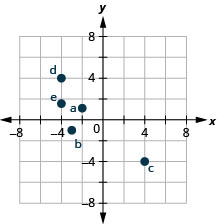
Up to now, all the equations you have solved were equations with just one variable. In almost every case, when you solved the equation you got exactly one solution. But equations can have more than one variable. Equations with two variables may be of the form Ax + By = C. An equation of this form is called a linear equation in two variables.
Here is an example of a linear equation in two variables, x and y.

The equation y = −3x + 5 is also a linear equation. But it does not appear to be in the form Ax + By = C. We can use the Addition Property of Equality and rewrite it in Ax + By = C form.
|
Steps
|
Algebraic |
| y = −3x + 5 | |
| Add to both sides. | y + 3x = −3x + 5 + 3x |
| Simplify. | y + 3x = 5 |
| Use the Commutative Property to put it in Ax + By = C form. | 3x + y = 5 |
By rewriting y = −3x + 5 as 3x + y = 5, we can easily see that it is a linear equation in two variables because it is of the form Ax + By = C. When an equation is in the form Ax + By = C, we say it is in standard form of a linear equation.
Standard Form of Linear Equation
A linear equation is in standard form when it is written Ax + By = C.
Most people prefer to have A, B, and C be integers and A ≥ 0 when writing a linear equation in standard form, although it is not strictly necessary.
Linear equations have infinitely many solutions. For every number that is substituted for x there is a corresponding y value. This pair of values is a solution to the linear equation and is represented by the ordered pair (x, y). When we substitute these values of x and y into the equation, the result is a true statement, because the value on the left side is equal to the value on the right side.
Solution of a Linear Equation in Two Variables
An ordered pair (x, y) is a solution of the linear equation Ax + By = C, if the equation is a true statement when the x– and y-values of the ordered pair are substituted into the equation.
Linear equations have infinitely many solutions. We can plot these solutions in the rectangular coordinate system. The points will line up perfectly in a straight line. We connect the points with a straight line to get the graph of the equation. We put arrows on the ends of each side of the line to indicate that the line continues in both directions.
A graph is a visual representation of all the solutions of the equation. It is an example of the saying, “A picture is worth a thousand words.” The line shows you all the solutions to that equation. Every point on the line is a solution of the equation. And, every solution of this equation is on this line. This line is called the graph of the equation. Points not on the line are not solutions!
The graph of a linear equation Ax + By = C is a straight line.
- Every point on the line is a solution of the equation.
- Every solution of this equation is a point on this line.
Try it!
The graph of y = 2x − 3 is shown.
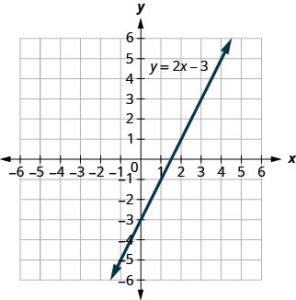 For each ordered pair, decide:
For each ordered pair, decide:
a. Is the ordered pair a solution to the equation?
b. Are the following points on the line?
A: (0, −3) B: (3, 3) C: (2, −3) D: (−1, −5)
Solution
Substitute the x– and y-values into the equation to check if the ordered pair is a solution to the equation.
a. b. Plot the points (0, −3), (3, 3), (2, −3), and (−1, −5).
b. Plot the points (0, −3), (3, 3), (2, −3), and (−1, −5).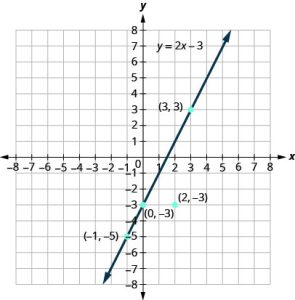 The points (0, 3), (3, −3), and (−1, −5) are on the line y = 2x − 3, and the point (2, −3) is not on the line.
The points (0, 3), (3, −3), and (−1, −5) are on the line y = 2x − 3, and the point (2, −3) is not on the line.
The points that are solutions to y = 2x − 3 are on the line, but the point that is not a solution is not on the line.
Graph an Equation by Plotting Points
There are several methods that can be used to graph a linear equation. The first method we will use is called plotting points, or the Point-Plotting Method. We find three points whose coordinates are solutions to the equation and then plot them in a rectangular coordinate system. By connecting these points in a line, we have the graph of the linear equation.
Try it!
Graph the equation y = 2x + 1 by plotting points.
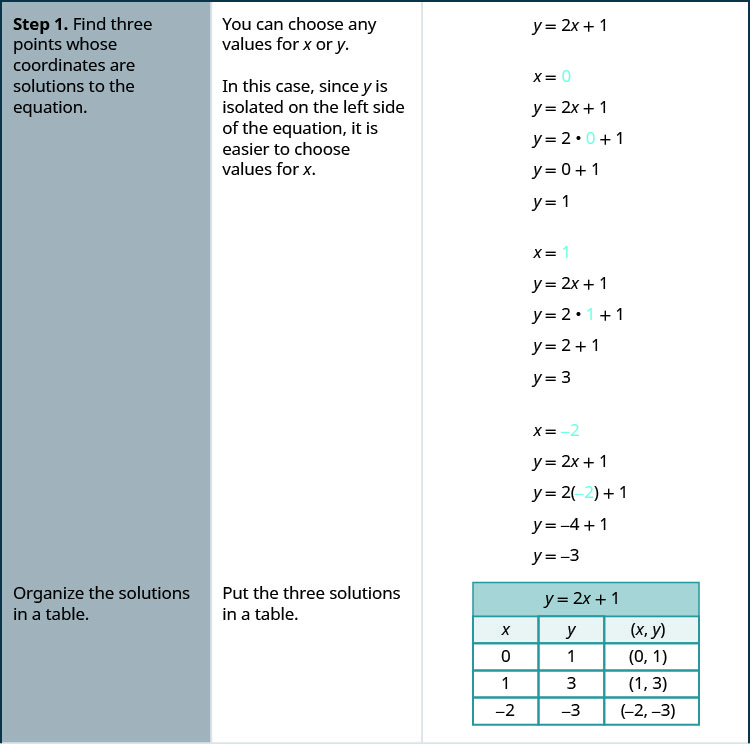
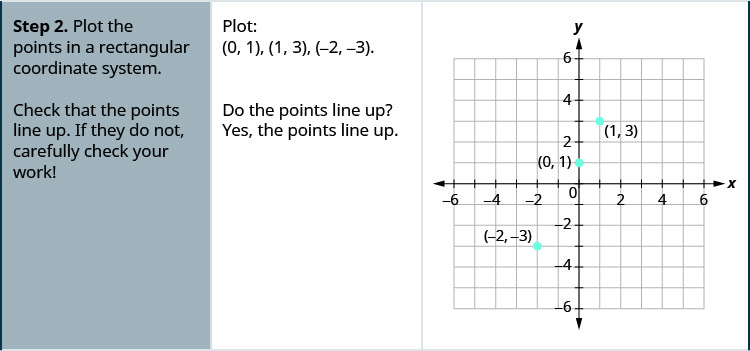
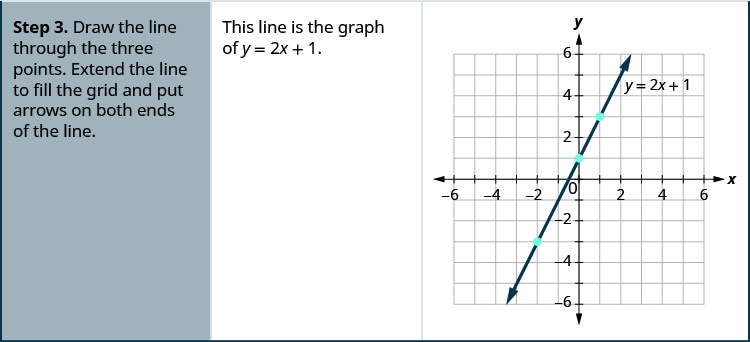
- Find three points whose coordinates are solutions to the equation. Organize them in a table.
- Plot the points in a rectangular coordinate system. Check that the points line up. If they do not, carefully check your work.
- Draw the line through the three points. Extend the line to fill the grid and put arrows on both ends of the line.
It is true that it only takes two points to determine a line, but it is a good habit to use three points. If you only plot two points and one of them is incorrect, you can still draw a line but it will not represent the solutions to the equation. It will be the wrong line.
If you use three points, and one is incorrect, the points will not line up. This tells you something is wrong and you need to check your work. Look at the difference between these illustrations.
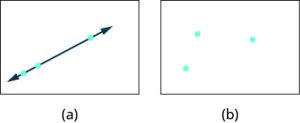
When an equation includes a fraction as the coefficient of x, we can still substitute any numbers for x. But the arithmetic is easier if we make “good” choices for the values of x. This way we will avoid fractional answers, which are hard to graph precisely.
Try it!
Graph the equation:
y = ![]() .
.
Solution
Find three points that are solutions to the equation. Since this equation has the fraction ![]() as a coefficient of x, we will choose values of x carefully. We will use zero as one choice and multiples of 2 for the other choices. Why are multiples of two a good choice for values of x? By choosing multiples of 2 the multiplication by
as a coefficient of x, we will choose values of x carefully. We will use zero as one choice and multiples of 2 for the other choices. Why are multiples of two a good choice for values of x? By choosing multiples of 2 the multiplication by ![]() simplifies to a whole number.
simplifies to a whole number.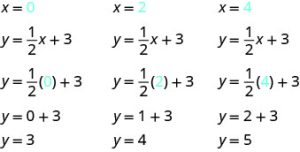 The points are shown in the table below.
The points are shown in the table below.
| y = |
||
|---|---|---|
| x | y | (x, y) |
| 0 | 3 | (0, 3) |
| 2 | 4 | (2, 4) |
| 4 | 5 | (4, 5) |
Plot the points, check that they line up, and draw the line.
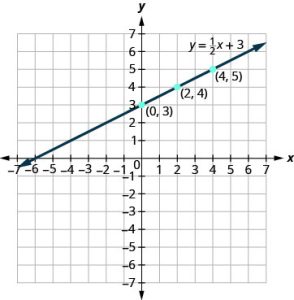
What if the graph is NOT Linear?
Suppose we want to graph the equation y = 2x − 1. We can begin by substituting a value for x into the equation and determining the resulting value of y. Each pair of x– and y-values is an ordered pair that can be plotted. The table lists values of x from –3 to 3 and the resulting values for y.
| x | y = 2x − 1 | (x, y) |
|---|---|---|
| −3 | y = 2(−3) −1 = −7 | (−3, −7) |
| −2 | y = 2(−2) −1 = −5 | (−2, −5) |
| −1 | y = 2(−1) −1 = −3 | (−1, −3) |
| 0 | y = 2(0) −1 = −1 | (0, −1) |
| 1 | y = 2(1) − 1= 1 | (1, 1) |
| 2 | y = 2(2) −1 = 3 | (2, 3) |
| 3 | y = 2(3) −1 = 5 | (3, 5) |
We can plot the points in the table. The points for this particular equation form a line, so we can connect them. This is not true for all equations.
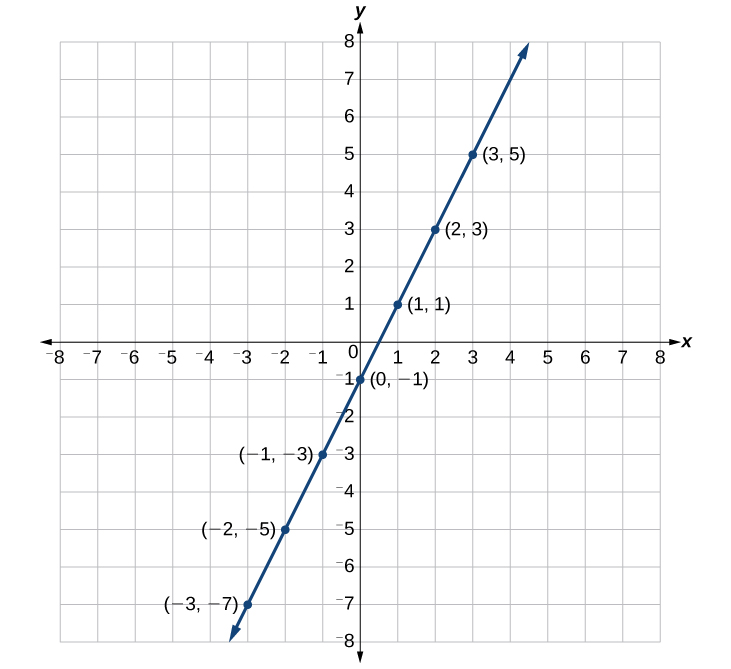
Note that the x-values chosen are arbitrary, regardless of the type of equation we are graphing. Of course, some situations may require particular values of x to be plotted in order to see a particular result. Otherwise, it is logical to choose values that can be calculated easily, and it is always a good idea to choose values that are both negative and positive. There is no rule dictating how many points to plot, although we need at least two to graph a line. Keep in mind, however, that the more points we plot, the more accurately we can sketch the graph.
How to graph by plotting points given an equation.
- Make a table with one column labeled x, a second column labeled with the equation, and a third column listing the resulting ordered pairs.
- Enter x-values down the first column using positive and negative values. Selecting the x-values in numerical order will make the graphing simpler.
- Select x-values that will yield y-values with little effort, preferably ones that can be calculated mentally.
- Plot the ordered pairs.
- Connect the points if they form a line.
Try it!
- Graph the equation y = −x + 2 by plotting points.
Solution
First, we construct a table. Then we choose x values and calculate y.
| x | y = −x + 2 | (x, y) |
|---|---|---|
| −5 | y = −(−5) + 2 = 7 | (−5, 7) |
| −3 | y = −(−3) + 2 = 5 | (−3, 5) |
| −1 | y = −(−1) + 2 = 3 | (−1, 3) |
| 0 | y = −(0) + 2 = 2 | (0, 2) |
| 1 | y = −(1) + 2 = 1 | (1, 1) |
| 3 | y = −(3) + 2 = −1 | (3, −1) |
| 5 | y = −(5) + 2 = −3 | (5, −3) |
Now, plot the points. Connect them if they form a line.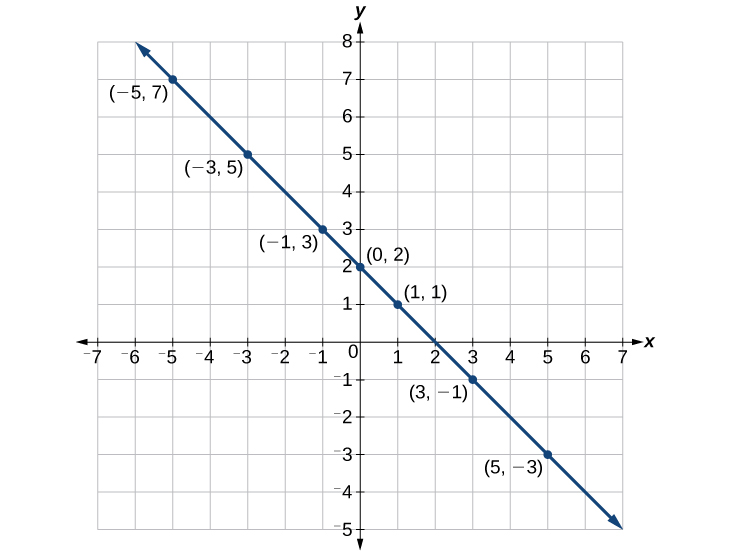
Try it!
Construct a table and graph the equation by plotting points: ![]() .
.
Solution
| x | Algebraic | (x, y) |
|---|---|---|
| x | (x, y) | |
| −2 | (−2, 1) | |
| −1 | (−1, |
|
| 0 | y = |
(0, 2) |
| 1 | y = |
(1, |
| 2 | y = |
(2, 3) |
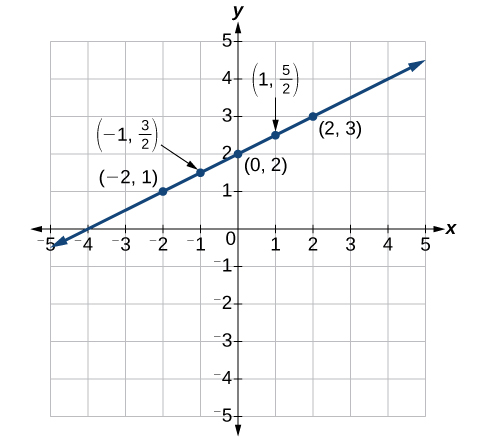
Find x and y Intercepts
The intercepts of a graph are points at which the graph crosses the axes. The x-intercept is the point at which the graph crosses the x-axis. At this point, the y-coordinate is zero. The y-intercept is the point at which the graph crosses the y-axis. At this point, the x-coordinate is zero.
Let’s look at the graphs of the lines.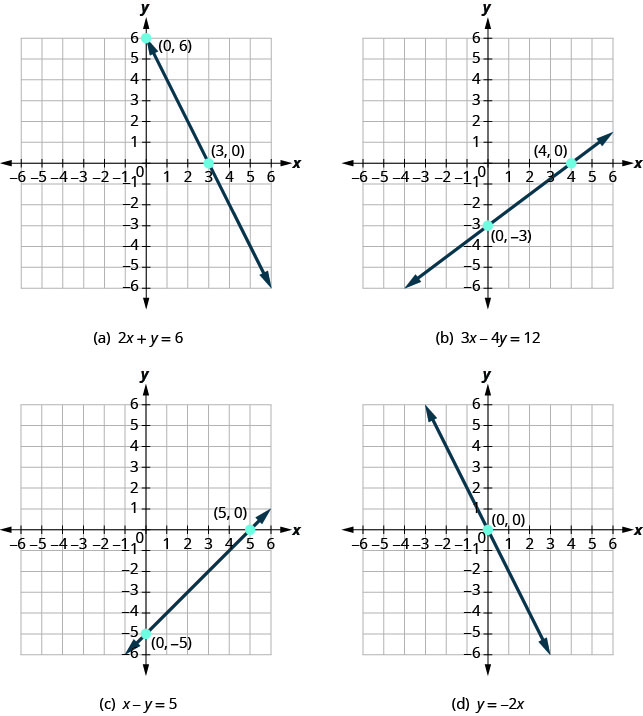 First, notice where each of these lines crosses the x-axis. Now, let’s look at the points where these lines cross the y-axis.
First, notice where each of these lines crosses the x-axis. Now, let’s look at the points where these lines cross the y-axis.
| Figure | The line crosses the x-axis at: |
Ordered pair for this point |
The line crosses the y-axis at: |
Ordered pair for this point |
|---|---|---|---|---|
| Figure (a) | 3 | (3 ,0) | 6 | (0, 6) |
| Figure (b) | 4 | (4, 0) | −3 | (0, −3) |
| Figure (c) | 5 | (5, 0) | −5 | (0, 5) |
| Figure (d) | 0 | (0, 0) | 0 | (0, 0) |
| General Figure | a | (a, 0) | b | (0, b) |
Do you see a pattern?
For each line, the y-coordinate of the point where the line crosses the x-axis is zero. The point where the line crosses the x-axis has the form (a, 0) and is called the x-intercept of the line. The x-intercept occurs when y is zero.
In each line, the x–coordinate of the point where the line crosses the y-axis is zero. The point where the line crosses the y-axis has the form (0, b) and is called the y-intercept of the line. The y-intercept occurs when x is zero.
x-intercept and y-intercept of a Line
|
The x-intercept is the point (a, 0) where the line crosses the x-axis. Occurs when y is zero. The y-intercept is the point (0, b) where the line crosses the y-axis. Occurs when x is zero. |
 |
Try it!
Find the x– and y-intercepts on each graph shown.
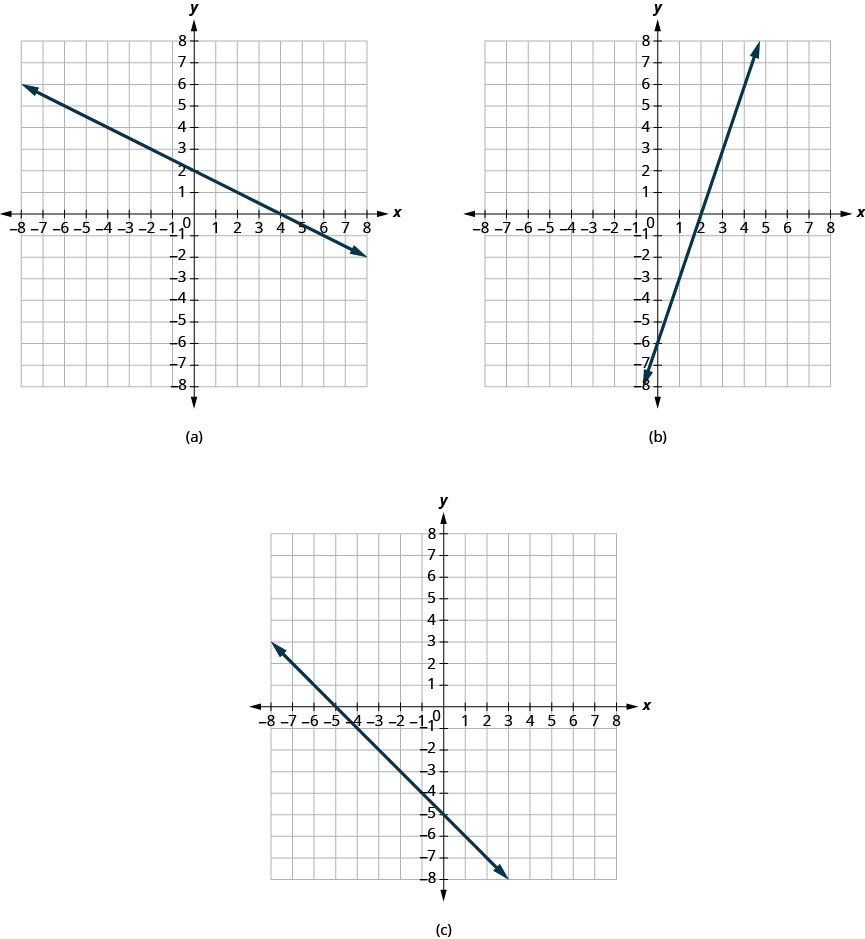
Solution
a. The graph crosses the x-axis at the point (4, 0). The x-intercept is (4, 0).
The graph crosses the y-axis at the point (0, 2). The y-intercept is (0, 2).
b. The graph crosses the x-axis at the point (2, 0). The x-intercept is (2, 0).
The graph crosses the y-axis at the point (0, −6). The y-intercept is (0, −6).
c. The graph crosses the x-axis at the point (−5, 0). The x-intercept is (−5, 0).
The graph crosses the y-axis at the point (0, −5). The y-intercept is (0, −5).
Key Concepts
- Points on the Axes
- Points with a y-coordinate equal to 0 are on the x-axis, and have coordinates
(a, 0). - Points with an x-coordinate equal to
0 are on the y-axis, and have coordinates(0, b).
- Points with a y-coordinate equal to 0 are on the x-axis, and have coordinates
- Quadrant
| Quadrant I | Quadrant II | Quadrant III | Quadrant IV |
|---|---|---|---|
| (x, y) | (x, y) | (x, y) | (x, y) |
| (+, +) | (−, +) | (−, −) | (+, −) |
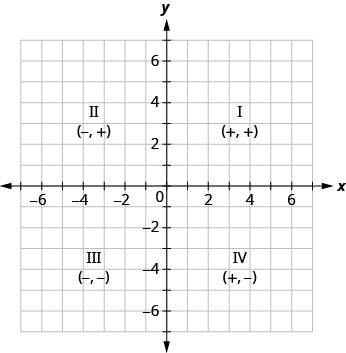
- Graph of a Linear Equation: The graph of a linear equation Ax + By = C is a straight line.
Every point on the line is a solution of the equation.
Every solution of this equation is a point on this line. - How to graph a linear equation by plotting points.
- Find three points whose coordinates are solutions to the equation. Organize them in a table.
- Plot the points in a rectangular coordinate system. Check that the points line up. If they do not, carefully check your work.
- Draw the line through the three points. Extend the line to fill the grid and put arrows on both ends of the line.
- x-intercept and y-intercept of a Line
- The x-intercept is the point
(a, 0) where the line crosses the x-axis. - The y-intercept is the point
(0, b) where the line crosses the y-axis.

- The x-intercept is the point

